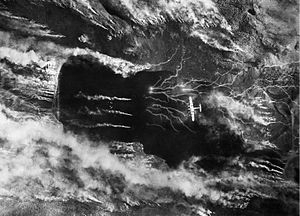| Operation Paravane | |||||||
|---|---|---|---|---|---|---|---|
| Part of World War II | |||||||
 A British Lancaster bomber over Kaafjord during Operation Paravane | |||||||
| |||||||
| Belligerents | |||||||
|
|
| ||||||
| Commanders and leaders | |||||||
|
|
| ||||||
| Casualties and losses | |||||||
|
11 killed 6 or 7 heavy bombers destroyed in accidents |
Battleship Tirpitz heavily damaged 5 killed, 15 wounded | ||||||
Operation Paravane was a British air raid of World War II that inflicted heavy damage on the German battleship Tirpitz, at anchor in Kaafjord in the far north of German-occupied Norway. The attack was conducted on 15 September 1944 by 21 Royal Air Force heavy bombers, which flew from an airfield in the north of the Soviet Union. The battleship was struck by one bomb, and further damaged by several near misses. This damage rendered Tirpitz unfit for combat, and she could not be repaired as it was no longer possible for the Germans to sail her to a major port.
The attack on 15 September followed a series of raids conducted against Tirpitz with limited success by Royal Navy carrier aircraft between April and August 1944, seeking to sink or disable the battleship at her anchorage, so that she no longer posed a threat to Allied convoys travelling to and from the Soviet Union. The first of these raids was successful, but the other attacks failed due to shortcomings with the Fleet Air Arm's strike aircraft and the formidable German defences. As a result, the task of attacking the battleship was transferred to the RAF's Bomber Command. Avro Lancaster bombers from the Command's two elite squadrons flew to their staging airfield in the Soviet Union on the night of 11/12 September, and attacked on 15 September using heavy bombs and air-dropped mines. All of the British aircraft returned to base, though one of the Lancasters later crashed during its flight back to the United Kingdom.
Following Operation Paravane, the German Navy's commander decided to use Tirpitz as a static artillery battery to protect the town of Tromsø. The Allies were unable to confirm the extent of the battleship's damage, and conducted two more heavy bomber raids against her in late 1944, Operation Obviate on 29 October, and Operation Catechism on 12 November. Tirpitz was sunk with considerable loss of life during the second of these attacks.
- ^ Bishop 2012, pp. 339, 341.